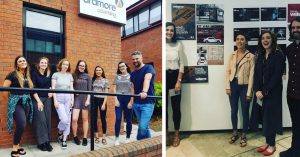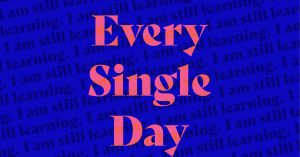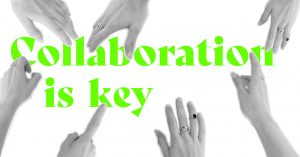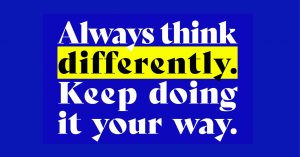Did you know you always wanted to take on a creative role? What first piqued your interest about this kind of role?
When I first undertook my art and design degree, I initially wanted to go into pottery (believe it or not!). I think I was trying to go against the family… as both my brother and father were graphic designers and I had vowed to never follow suit… you can see how well that turned out.
It wasn’t until I took part in the PANI Student Advertising Programme that the world of advertising started to make sense to me. Luckily, alongside several other students, I was assigned to the Ardmore team and worked closely with our current Creative Director Chris Lyttle to bring our student campaign to life and eventually go on to win the programme.
It was my first real taste of the industry. We were in the Ardmore studio every week, working alongside creatives, designers, strategic planners, and copywriters – it was a world of fun. Each person working together, collaborating and all the while sharing a few laughs. That led me on to join Ardmore as a Junior Creative during my placement year. The role involved everything from design to conceptual work. It relied heavily on understanding how and why people work the way they do. It required research, understanding, conceptual thinking and the ability to present and pitch ideas to a wide range of teams and individuals. I’ve always been a bit of a deep thinker – constantly with my head in the clouds and I obsess over the strangest things – all of which seemed to really help fuel and push my creative ideas.
When it comes to creativity as a skill, how much do you think is a natural part of personality, how much can be taught and learned?
When it comes to creativity, I think all of us at Ardmore understand that a creative idea can come from anyone and at any time. No idea is stupid, and no person can be wrong in the initial ideas stage. But the real skill is knowing a good idea when you see one. Sure, there are lots of techniques you can use to develop creative ideas, launch brainstorming sessions and plant ‘seeds’ of an idea. But to recognise a great idea – in its early form – is key. Sometimes the most bizarre ideas are the best solutions.
Some technical skills you can teach, there are endless YouTube videos now. You can read books and watch presentations on creativity and campaigns. But for creatives, the best way for us to reach our audiences is to understand them and to do that, you must take part in life. You must be enthusiastic and willing to learn new things. You must have an open mind and see the world for what it is. Dive straight in and enjoy yourself. Our best ideas come from a place of enjoyment or discomfort.
What has been your favourite/most rewarding campaign to have worked on?
Win or lose some of my favourite work has been completed during late-night pitches and long weekends. There’s just something about an entire team working toward one goal. Supporting and encouraging each other through every stage – when you can work down to the wire and still share a laugh, that’s when you know you’ve struck gold.
The best campaigns are the ones that create positive change. Like our Samaritans Young Person Campaign, which was Highly Commended in the 2021 Drum Social Media Awards. It’s fantastic to work for a great cause and even better when we see the metrics of such a campaign, to understand how many people it reached and how many conversions were made for people seeking help. It really is quite a sobering figure.
What has been the most challenging campaign you have worked on?
I find sometimes the hardest campaigns to work on are those that are close to your heart. It can be hard to separate personal feelings from the reality of campaign objectives and metrics. For instance, we recently worked on a climate change brief, and it was really an all-encompassing ask. Focussed on changing behaviours and inspiring positive habits. That’s such a massive task and when the reality of climate change and global disruption is on our doorstep, it can be hard to try and stay within budgets (and the realms of reality). But at the end of the day, if the most challenging campaigns are the ones you care most about – that’s not a bad place to be in.
What are the most challenging aspects of this role and how do you work through these?
For me, being so early into my career, the hardest part can be knowing what I don’t know and where my role ends and another begins. I want to do everything all the time. And it can be hard to let go of work, or hand it over. But you soon learn the more you work and collaborate as a team, the better the work gets, so that’s always inspiring. I’m still learning every day, and I know that doesn’t ever stop, but knowing when you should have a voice/opinion and when you should sit back and listen, is a big skill. Understanding where you can add value and where you can step back and let other people shine. This is key.
What are the most useful resources you’ve found that have helped you through your career journey?
Mentors, mentors and mentors! I’d be in a very different place in my career if it wasn’t for all the amazing mentors along the way. They don’t just fall in your lap (Well luckily for me my best mentor was my first ever desk buddy in Ardmore) But you really have to seek them out – people that are ready to invest in you. People who have a wealth of experience (not just in advertising, but in life) and people who help lift you up, challenge and push you to try harder every day. We can’t work in silos and sometimes we are our worst critics. We all need people around us whom we can bounce ideas off, learn from and share the wins and losses.
What is your favourite thing about Ardmore?
The team mentality. In our creative studio, there’s a real team effort mentality. Constant support and pushing each other to make better work than yesterday. With a big learning focus. We’re constantly looking for new techniques or different ways to do things and teaching each other along the way. When you’re starting out in the industry you constantly have lectures and education platforms reminding you of the ‘hierarchy’ in agencies. And how you must ‘work your way up.’
In Ardmore, those lines are so blurred (in the best way) that you never feel there is a hierarchy, ideas come from anywhere, you help on whatever work you can, wherever you can, and every person feels they have a voice. No day is ever the same, and you never know what the next day has in store for you.
Where do you see yourself in 5 years?
In the next five years, I want to continue to develop my knowledge and understanding of the industry. It’s such early days for me and I’m so excited about how much more I have to learn. My favourite part of working as a creative right now is understanding how people think, finding ways to surprise and delight audiences with advertising that adds value and where possible, encouraging positive behaviour change. I want to continue to do that, but I also hope to challenge myself to grow in new ways, including creative strategy, film production and larger-scale projects.
Above all else, I hope in 5 years I finish each day having either laughed, cried or cheered.
I know it’s cliché – but life really is too short for the mundane.


